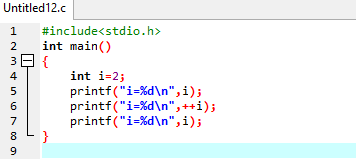Operators
in C Part 3 :
Assignment Operators :
Assignment operators are used as part of assignment
expressions , which assign the value of an expression to an identifier .
The most commonly used assignment operator is the
equal sign(=).
Assignment expressions are written in the form
identifier = expression;
the assignment operator assumes there is a variable
name to the left of the expression to its right. The expression may be
arithmetic , relational ,logical or another assignment. It takes the value of
the expression and store it in the variable .
Examples :
· A=3
· X=y
· Sum=a+b
The assignment operator = and the equality operator
== are distinctly different.
An assignment operator is used to assign a value to
identifier , whereas the equality operator is used to determine if the two
expressions have the same value.
Multiple Assignments:
C allows use of multiple assignment operators .
Multiple assignment operators are evaluated from
right to left .
It shall take the form of :
identifier1=identifier2=…….=expression;
This expression is equal to the statement
Identifier1=(identifier2 = expression);
Example program :
Output :
In the second assignment statement , the expression
y=6 is evaluated first and then the value of the expression is assigned to the
variable z.
Other Assignment operators :
The other assignments are +=
, -= , *= , /= ,
%= .
The assignment expression “ expression1+= expression2; ” is
equivalent to the expression:
“ expression1=expression1+expression2; “
for example :
i+=5 which is equivalent to i=i+5
.
Conditional Operator (Or) Ternary operator :
A conditional
operators forms an expression that will be having one of two values , depending
on the truth value of another expression .
The expression can be written in the place of an
if-else statement .
A conditional expression is written in the form
expression1 ? expression2 : expression3 ;
when evaluating a conditional expression , expression1 is evaluated first . if
expression1 is true (i.e, if the value is non zero), then expression2 is
evaluated and this becomes the value of the conditional expression.
Example program :
Output :
Bitwise operator :
Bitwise operation refers to testing, setting or
shifting the actual bits in a byte or a word , which corresponds to the char
and int data types and variants.
We cannot use
bitwise operation on float, double ,long double ,void, bool or other types.
Operator
|
Action
|
&
|
AND
|
|
|
OR
|
^
|
Exclusive
OR(XOR)
|
~
|
One’s
complement(NOT)
|
>>
|
Shift
right
|
<<
|
Shift
left
|
Other Operators :
Comma
(,) operator
|
Used
during sequence of operations
|
Dot(.)
and Arrow (->) operators
|
These
operators access individual elements.
|
Square
bracket[] operator
|
It
performs array indexing
|
To see more posts visit :https://iamafutureprogrammer.blogspot.com
Thank you ….














![Java Code 3 _ Two - digit " Reduced Subtracted Form " [Wipro Interview Question]](https://blogger.googleusercontent.com/img/b/R29vZ2xl/AVvXsEjfknAUiMwSb6Ma-V3Usa9M-80j4etXJF3-Ns2u_azXAb33KPwfsvZtP17a2Tu1aLYKhCOmcG5ivzogedb8cXJzdE-Qd_q5VKx_VthmzjgrnnTYD0VYXoBSId6fvfoqTTXf2JRF_wij0Rw/w72-h72-p-k-no-nu/Screenshot+%252819%2529.png)


